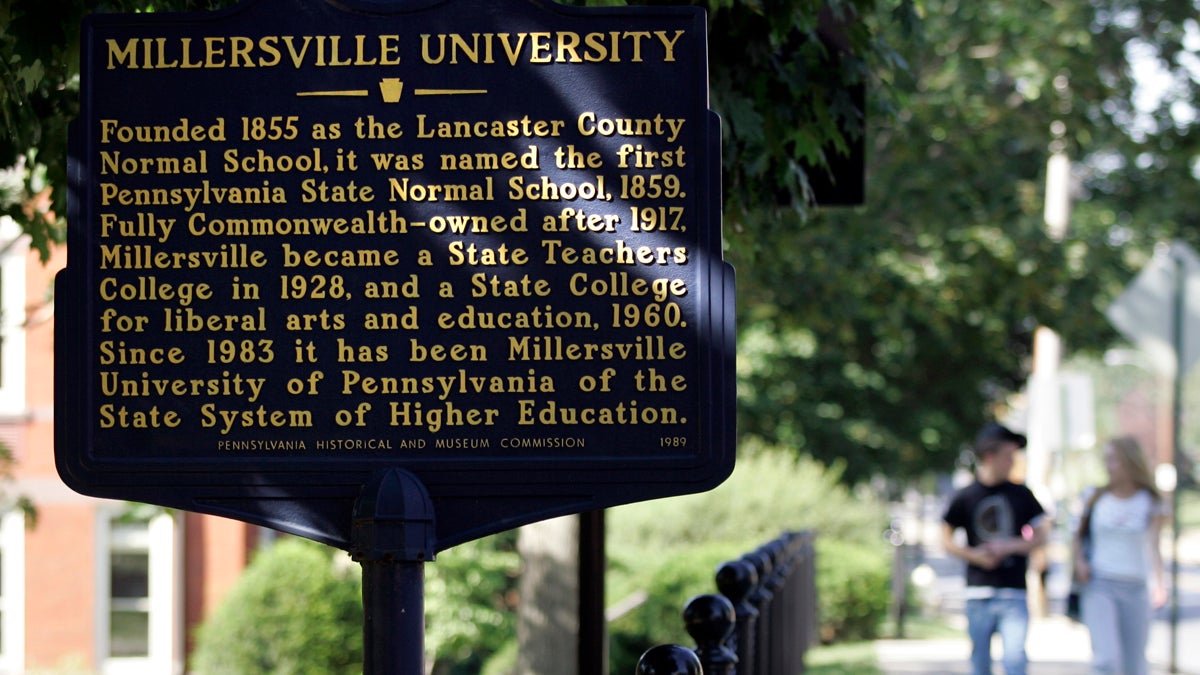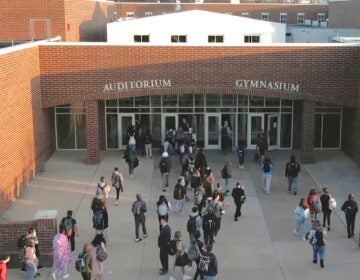With bipartisan support, two Pa. lawmakers hope to freeze tuition at state system colleges

Two Pennsylvania legislators are co-sponsoring a bill calling for the State System of Higher Education to freeze tuition at its 14 colleges for five years. (AP file photo)
Two lawmakers in Pennsylvania’s House of Representatives hope to address what’s become major issues for many millennials — college affordability and student debt — when the General Assembly reconvenes in Harrisburg later this month.
Reps. Kevin Boyle and Nick Miccarelli are co-sponsoring a bill to freeze tuition for five years at the universities that make up Pennsylvania’s State System of Higher Education, which include West Chester and Millersville.
If successful, it would be only the second time in the system’s 33-year history it did not raise tuition.
“We have the problem that — regardless of if [former] Gov. Rendell is funding them at record levels or [former] Gov. Corbett is cutting or Gov. Wolf is attempting to fund — that the tuition increase stays the same regardless of the state appropriation,” said Miccarelli, R-Delaware.
The Republican from Delaware County says the bill is not seeking more state funding for the universities, which serve more than 100,000 undergraduates.
“We’re asking our residents to pay a very, very challenging amount in their tax bills every year,” he said. “So long as we’re doing that, I think it’s imperative on the legislature to use our oversight to ensure that that money that we take from our citizens is being used as efficiently as possible.”
State system spokesman Kenn Marshall says the system has the lowest tuition among the state’s publicly supported universities and below average tuition for the Mid-Atlantic region, according to the College Board.
The measure, which has bipartisan support, also includes a 2 percent cap on any tuition increases after the freeze ends.
While there is no mandate for increased state aid, co-sponsor Boyle, D-Philadelphia, said the schools need more funding.
Funding down, enrollment and tuition up
“I want to be very clear. I am a supporter of increased funding for higher ed. This is not an ‘either or’ situation … the political culture in Harrisburg in 2016 just fundamentally is not going to allow for that bill [with increased state funding] to ever successfully go through the legislature,” he said. “But while we wait for perfection, I don’t think that we can walk away from what would actually be good public policy.”
Boyle said he doesn’t want to see a public college education become unrealistic for young people in his city district.
Full-time undergraduates pay an in-state tuition of $7,238 at the state-owned schools that continue to operate at 1999 funding levels. The system serves16 percent more students than it did 17 years ago. They’ve cut $300 million in the last decade and have 1,000 fewer employees.
The amount spent per student isn’t that different from 10 or 15 years ago, Marshall said. The difference is the source of revenue.
Pennsylvania used to supply 65 percent of the cost of attendance at state system universities, but now only covers 25 percent. Tuition makes up the difference, and that has gone up 18 percent in five years.
Some of the biggest expenses — pensions and health care — are mandated costs that increase annually, Marshall said. The system has no control over that.
“The state establishes the pension rate and also who we have to provide pensions to,” he said. “We have to pay for those. We don’t have a choice.”
That curtails other spending, he said, and the consequences of that are more likely to affect students.
“The state is really tying [the state system’s] hands,” said Joni Finney, director of the Institute for Research on Higher Education at the University of Pennsylvania. “The state is not undergoing pension reform. The state basically said they’ll be no more money, if that’s true. And they’ll be no more tuition revenue.
“If Pennsylvania wants to race to the bottom in terms of levels of education achievement, then this is a sure way to do it.”
The bill would apply to the 2017-18 academic year.
The burden of responsibility
A national report found Pennsylvania ranks as the second worst state in the country for college affordability.
Finney, one of the report’s authors, said many states have frozen tuition, and most have failed to use that time to come up with a long-term plan for financing higher education.
It’s politically difficult to increase state appropriations, but, without that, the burden of responsibility is just pushed onto universities, she said.
“It’s easier to say to the institution, ‘You know, you fix all of the problems. We’re going to restrict all your revenue, and you fix the problem,'” she said. “The institutions have to do their fair share. The state has to do its fair share, and students and family have to do its fair share.”
Finney would like to see tuition increases tied to growth in family income.
“If the median level was going up, tuition could go up at the same rate. If family income was flat or declining, you would freeze tuition,” she said. “There’s some predictability so families know five years from now, ‘This is the basis for tuition.'”
The legislation came about after Boyle and Miccarelli founded and now co-chair the Pennsylvania Future Caucus last year, which is part of the Millennial Action Project. The Washington, D.C.-based nonprofit aims to bring young lawmakers together to do bipartisan work on issues facing millennials.
How to pay for college is the No. 1 one concern young people say they have, he said.
“Hopefully, the longer solution is increased education funding,” Boyle said. “I’m certainly not someone who believes that this is the cure-all when it comes to college affordability, but I believe it is the first step.”
The ‘important majors’
Miccarelli also called on the state system to focus on better preparing students for the job market.
“We need to ensure that there are schools that can educate the kids, not just in what they want to learn, but in what positions will be there at the end of the road,” he said. “I see horror stories all over the country of crazy majors, ones in the color blue in New York. I don’t open the Delaware County Times or the Philadelphia Inquirer and see ‘Wanted: Major in the color blue.'”
But Marshall said the system is already at the forefront of addressing Pennsylvania’s workforce needs. Five years ago, it began assessing its offerings and has since developed 100 new programs.
“Virtually all of those programs have been designed in direct cooperation with industry, with employers,” he said.
STEM majors have increased nearly 37 percent during that time, according to Marshall.
Focusing on “important majors” will help develop the state’s future workforce and also keep tuition reasonable, Miccarelli said.
“If this money is not being spent on educating for jobs that will be here in Pennsylvania in four years, we need to look at that money and wonder what we’re doing with it,” he said.
These statements echo similar sentiments from several Republican governors who want to fund only classes at public universities that would lead to jobs.
“So that’s the Chinese model of higher education,” said Finney, the higher ed expert. “You determine how many people you need in given areas, and those are the slots you provide in higher education for those majors. And that hasn’t that worked very well for the Chinese economy. We are completely unable to determine how quickly a global economy will change.”
She also pointed out that liberal arts majors do quite well in terms of the economic return of higher education.
“If you look at the success of the American economy, American entrepreneurs are often credited with creativity,” Boyle, a political science major, said. “I think that an overemphasis on math and sciences can certainly not cultivate that part of the brain that leads to entrepreneurship, and obviously to be a successful entrepreneur, more times than not, you need to be a very creative person.”
The 14 universities that make up state system are: Bloomsburg, California, Cheyney, Clarion, East Stroudsburg, Edinboro, Indiana, Kutztown, Lock Haven, Mansfield, Millersville, Shippensburg, Slippery Rock and West Chester.
Correction: An earlier version of this story misstated the percentage cap on tuition increases.
WHYY is your source for fact-based, in-depth journalism and information. As a nonprofit organization, we rely on financial support from readers like you. Please give today.




